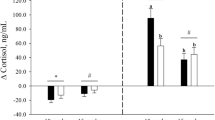Summary
The effect of high ambient temperature (34‡C) on the function of the female reproductive system, on embryonic development and on outcome of pregnancy, was investigated in heat-exposed sham-operated (Sh) and pinealectomized (Px) golden hamsters maintained under short photoperiod. Plasma prolactin levels were reduced in both heat-exposed groups (ShH and PxH) but pituitary prolactin was increased in the pinealectomized groups irrespective of ambient temperature (21 or 34 ‡C). Pituitary weights and LH contents were not affected in any test group. Heat exposure brought about a reduction in the number of corpora lutea and of pups born, the latter being more drastically reduced in absence of the pineal; the depressant effect of heat on ovarian weight was evident only in the pinealectomized animals. Progesterone levels were not affected in any test group and pregnancy was not prolonged, thus, it would seem that pregnant hamsters adapt themselves well to heat. Moreover, high ambient temperature promoted a rise in pineal HIOMT activity and boosted cortisol levels in presence of the pineal gland only, which, together with the above findings, shows that the pineal can provide protection for pregnant hamsters against adverse effects of high ambient temperature.
Similar content being viewed by others
References
Bedrak E, Fried K, Samoiloff V, Sod-Moriah UA (1977) The effect of acclimation to elevated ambient temperature on progesterone levels in blood and corpora lutea of cycling and four-day pregnant rats. J Thermal Biol 2: 83–87
Fioretti MC, Riccardi C, Menconi E, Martini L (1974) Control of the circadian rhythm of the body temperature in the rat. Life Sci 14: 211–219
Kaplanski J, Magal E, Sod-Moriah UA, Hirschmann N, Nir I (1983) The pineal and endocrine changes in heat exposed male hamsters. J Neural Transm 58: 261–270
Karppanen H, Vapaatalo H, Labovaara S, Paasanen MK (1970) Studies with pinealectomized rats. Pharmacology 3: 76–84
Kuo EYH, Gala RR (1972) Radioimmunoassay of rat prolactin comparing prolactin obtained for AP organ culture with that distributed by NIAMDD. Biochim Biophys Acta 264: 462–471
Magal E, Kaplanski J, Sod-Moriah UA, Hirschmann N, Nir J (1981) The role of the pineal gland in male rats chronically exposed to increased temperature. J Neural Transm 50: 267–273
Magal E, Kaplanski J, Sod-Moriah UA, Hirschmann N, Nir J (1983) Effect of pinealectomy on heat-induced endocrine changes in female rats. Hormone Res 17: 222–227
McCormack JT, Greenwald GS (1974) Progesterone and Oestradiol 17: concentrations in the peripheral plasma during pregnancy in the mouse. J Endocr 62: 101–107
Miline R (1980) The role of the pineal gland in stress. J Neural Transm 47: 191–220
Nieswender GD, Midgley Jr AR, Monroe SE, Reichert Jr LE (1968) Radioimmunoassay for rat luteinizing hormone with antiovine LH serum and ovine LH131I. Proc Soc Exp Biol Med 128: 807–811
Nir I, Hirschmann N, Sulman FG (1972) Pineal gland changes of rats exposed to heat. Experientia 28: 701–703
Nir I, Hirschmann N (1978) Pineal N-acetyl transferase depression in rats exposed to heat. Experientia 34: 1645–1647
Nir I, Hirschmann N (1979) A thin Chromatographic assay for measuring pienal hydroxy-indole-o-methyltransferase. Experientia 35: 1426–1428
Nir I, Hirschmann N (1980) Melatonin-induced changes in blood and pituitary LH and prolactin levels during the perinatal period in rat dams. J Neural Transm 49: 219–228
Nir I, Hirschmann N, Sulman FG (1975) The effect of heat on rat pineal hydroxyindole-O-methyltransferase activity. Experientia 31: 867–868
Reiter RJ (1980) The pineal and its hormones in the control of reproduction in mammals. Endocr Rev 1: 109–131
Reiter RJ (1981) The pineal. Ann Res Rev 6: 96–117
Sod-Moriah UA (1971) Reproduction in the heat-acclimatized female rat as effected by high ambient temperature. J Reprod Fertil 26: 209–218
Sod-Moriah UA, Magal E, Kaplanski J, Hirschmann N, Nir J (1983) The role of pineal gland in thermoregulation in male hamsters. Comp Biochem Physiol 74A: 649–651
Sod-Moriah UA, Pollak E (1970) Food and water consumption and the reproductive performance of the heat-acclimated female rat. J Biometeor 14: 293–299
Vecsei P (1974) Glucocorticoids: cortisol, corticosterone and compounds. In: Jaffe BM, Behrman HR (eds) Methods of hormone radioimmunosassay. Academic Press, New York, pp 393–415
Yousefnejadian E, Florensa E, Collins WP, Somerville IF (1972) Radioimmunoassay of plasma progesterone. J Steroid Biochem 3: 893–896
Wiest WG (1970) Progesterone and 20-hydroxypregn-4-en-3-one in plasma, ovaries and uteri during pregnancy in the rat. Endocrinology 87: 43–48
Author information
Authors and Affiliations
Rights and permissions
About this article
Cite this article
Kaplanski, J. Pregnancy outcome in heat-exposed hamsters; the involvement of the pineal. J. Neural Transmission 73, 57–63 (1988). https://doi.org/10.1007/BF01244622
Received:
Accepted:
Issue Date:
DOI: https://doi.org/10.1007/BF01244622




